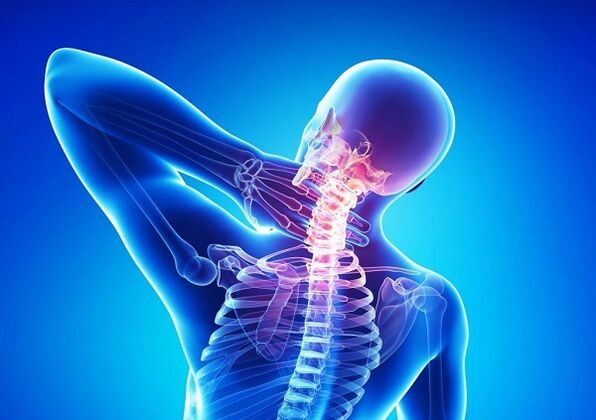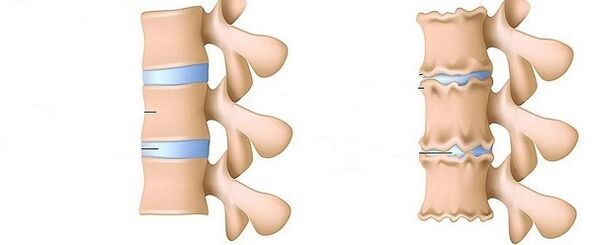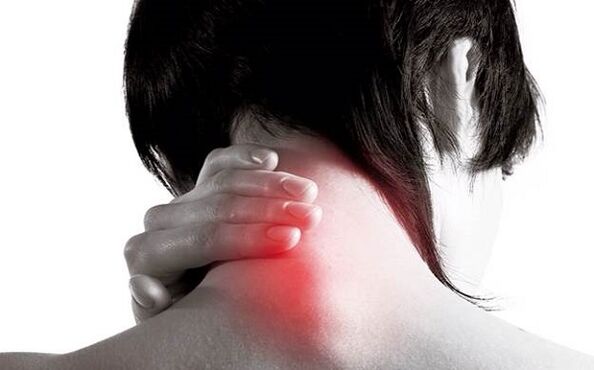Do you often feel pain in your neck and head, and the pain radiates to your arms and shoulders? Maybe you have cervical osteochondrosis and should be treated as soon as possible? How to diagnose the disease and which doctor to contact? And how to provide first aid for neck osteochondrosis? Read the rest of this article and more.
Disease characteristics
First, let us recall what kind of disease it is. Therefore, cervical osteochondrosis is a disease of the cervical intervertebral disc, and it is the most movable part of the cervical intervertebral disc. In most cases, the lesions occur at the level of the C5-C7 vertebrae. The symptoms of the disease also depend on the vertebrae it affects. It will be described in detail later.

The reason
To understand how to treat cervical osteochondrosis, we must first understand the cause of its appearance. First, let us say that this disease has become more and more common recently. The age risk zone is 25 to 40 years old. There may be many reasons for this disease. The most common are:
- Working in front of a computer, and driving frequently and for a long time;
- Inactive;
- Accumulation of salt in the cervical spine;
- Impaired metabolism;
- Malnutrition;
- Neck injury;
- Rheumatism;
- Genetic
- Hormonal disorders;
- Severe hypothermia, etc.

symptom
The disease has many symptoms, which can be manifested simultaneously or individually. It all depends on the affected area of the neck. Therefore, in order to know how to treat cervical osteochondrosis, you need to find out what is affected and the possible consequences. First, consider the general signs of cervical osteochondrosis.
- pain. Pain syndromes were observed in the neck, back of the head, and back of the shoulders. In addition, the hands may feel pain. 30% of headaches are attributed to this disease. All this is because the blood vessels of patients with osteochondrosis may be squeezed. As a result, the blood flow to the brain is reduced and severe headaches occur, accompanied by rapid fatigue.
- Crunch. When you turn your head and tilt your head, you will feel a characteristic strong crunch.
- numbness. It can occur in the scapula area and is accompanied by strong "back pain". In addition, the neck itself will become numb, and there will be a noticeably unpleasant tingling sensation in the arms and legs.
- Weakness and dizziness. In addition to this, frequent fainting may occur, drowsiness may occur, and general rapid fatigue may be observed.

If the treatment of cervical osteochondrosis will be done at home, then you still need to know how to accurately determine the area of the lesion. Here, you only need to know what symptoms will occur if one or the other nerve roots near the vertebrae are affected. There are a total of 8 such protrusions in the cervical spine, which are named C1-C8.
- C1-Following its failure, impaired sensitivity is observed in the occipital region.
- C2-Pain appears in the back of the head and on the top of the head.
- C3-The infringement is accompanied by severe pain in the area where it occurs. The sensitivity of the neck is reduced. Impaired taste sensitivity of the tongue. There may be language problems.
- C4-Liver and heart pain. There is also numbness and pain between the shoulder and scapula.
- C5-Upper shoulder pain and decreased sensitivity.
- C6-The area including the neck and scapula is very sore. The pain spreads to the shoulders and radiates to the arms, reaching the thumbs of the hands.
- C7-Symptoms are similar to C6, but the pain will spread to the back of the shoulder and the entire arm, affecting the rest of the fingers, except the little finger.
- C8-similar to C7. In addition, numbness and pain have reached the little finger.
Types of
Do you want to know if cervical osteochondrosis can be cured at home? Then you need to find out where your disease is. After all, only primary treatment can be done at home. In general, the 3 degrees of the disease can be distinguished according to the progression of the disease.
- The first one-almost unknowingly, you didn't even start thinking about how to deal with cervical osteochondrosis. But it is at this stage that it is possible to prevent the development of the disease. Symptoms include periodic numbness in the area between the neck and shoulder blades when sitting for long periods of time. Pain is rare, but it is accompanied by increased numbness and fatigue.
- The second type is the progression of the disease. The intervertebral discs have shrunk and deformed, but they can still be repaired. Any movement of the neck will feel tightness and pain, but the movement is restricted. Need immediate medical attention.
- The third is the late stage of the disease. The integrity of the disk here has been destroyed. The pain in the neck, head, and shoulders is almost constant. The pain will even spread to the hands, right down to the fingers. Diseases such as hernias are possible. With further deformities and improper fusion of the vertebrae, the struggle with the disease can only continue through surgical methods.
Where to go for help?
So, you have some signs of illness and you decide not to stand by and ask for help from experts. The question is brewing, "Which doctor treats cervical osteochondrosis? " Well, it all depends on the stage of your disease. Therefore, the treatment of 1 degree sore can be handled by a therapeutic gymnast or a masseur. This also includes alternative medicine, namely osteopathy and other directions.
Osteochondrosis of cervical spine 2 degree already needs to be observed by a doctor in a polyclinic. Here, humans, physical therapists or reflex therapists can deal with pain. In addition, consulting a neurologist is not superfluous. 3 degree cervical osteochondrosis requires more professional medical treatment. Here, the neurologist should deal with this disease first, because there are many nerve endings in the cervical spine. In advanced cases, surgeons work with neuropathologists to treat cervical osteochondrosis.

diagnosis
You must undergo an examination before treating osteochondrosis of the neck. The attending doctor will palpate the neck, perform several operations, and ask you. An X-ray of the cervical ridge must be prescribed. In addition, general blood tests will be prescribed. In order to understand the disease in more detail, they may be sent for an MRI or CT scan.
How is the treatment performed?
First, let us answer the question, "Can cervical osteochondrosis be cured? " Yes, it is possible, but it is only possible to fully cope with this disease at an early stage. So how to overcome cervical osteochondrosis? There are different ways to deal with this, as described below.
drug
Medicine is the most effective way to treat 2nd and 3rd degree cervical osteochondrosis. Complex processing is performed here. Therefore, some drugs should relieve the pain that torment you. Other drugs can fight inflammation. There are also some-to relieve swelling, the fourth medicine can restore blood circulation and provide nourishment to the diseased area. They can be in the form of tablets, injections and injections. For cervical osteochondrosis, the ointment will not be effective.

All treatments for cervical osteochondrosis in women and men are divided into 3 stages.
- First, the drug should quickly overcome pain, reduce edema and have an anti-inflammatory effect.
- In the second stage, each therapy should produce a regenerative healing effect.
- The third stage is the recovery period. This includes vitamins, therapeutic gymnastics and massage.
Because you have been tortured by osteochondrosis and decided to go to the hospital for treatment, please do not take your own medicine and follow the doctor's instructions.
physiotherapy
Physical therapy can answer how to treat cervical osteochondrosis. The most commonly used methods are:
- Magnetic therapy;
- electrotherapy;
- Laser Treatment;
- UFO;
- Other people's balneotherapy.
Surgical treatment
Sometimes, only a surgeon can answer how to get rid of cervical osteochondrosis. The operation was arranged after consulting a neurologist. Here, the surgeon should try as much as possible to make the osteochondrosis that beat you subside. After the operation, prepare for a long recovery process.
National Science
What will folk medicine say about all this? There are sufficient methods and means to treat this disease. However, please remember that your actions are at your own risk, so only you are responsible for the consequences. So, how to use folk remedies to treat osteochondrosis.
- The first method is to compress the leaves of Indian onion to treat cervical osteochondrosis. To do this, you need to take a leaf of a plant and wipe the diseased area with it, and then use the remainder as a dressing overnight. The healing effect should be observed the next morning.
- Another night dressing is made with cheese sprinkled with vinegar. Continue for several nights until the therapeutic effect appears.
- Horseradish leaves are used in a similar way. We take a freshly plucked plant leaf, rinse it with boiling water, and then apply it to the painful area overnight, before wrapping it with a warm thing.
- How to cure cervical osteochondrosis with a shovel? Here, everything is very simple. The fact is that we don’t need the entire shovel, but only a part of it, called a handle with a length of more than one meter. To use it to make magical medicine, you need to wrap it around your neck with both hands. In addition, as we move up and down, we massage the diseased area. This procedure should be performed several times a day for at least a week.

Treatment contraindications
Sometimes a problem arises, "What can and can't be done with cervical osteochondrosis? " According to reports, not all medical procedures always have only therapeutic effects. Sometimes they can be very harmful to the patient. Therefore, treatment is only worthwhile on the advice of the attending doctor. Therefore, this includes the following procedures for the treatment of osteochondrosis:
- acupuncture;
- Remedial gymnastics or exercise therapy;
- massage.
If you are 75 years of age or older and pregnant women, acupuncture and moxibustion for osteochondrosis are prohibited. The remaining contraindications of this procedure are the same as those of massage. This includes:
- Blood disease.
- Any type of bleeding.
- Increased mental excitement.
- Any breathing difficulties.
- Digestive system problems.
Exercise therapy or physical therapy complexes, such as osteochondrosis, also have contraindications. The most common are unhealed injuries, severe bruises and hematomas. The contraindications here also include:
- The rapid deterioration of the disease;
- Weak heart;
- Manifestations of tachycardia or arrhythmia;
- Severe diabetes;
- Bleeding tendency
- Infectious sores;
- Have diseases related to vestibular organs;
- Have vision problems;
- Nervous system symptoms that cause loss of coordination.
How to provide first aid?
If osteochondrosis takes you by surprise at home, the first aid methods are as follows:
- Take a normal dose of analgesics.
- Call the doctor at home because you may need more thorough methods and other medications.
- Try not to move your head or body suddenly.
- Remove the quilt from the bed, lie down, and put a small pillow under your head. If the mattress is soft enough, please lie on a bench or floor.
- Try to relax and think of some good things so that the painkillers will work faster. If the doctor is late, do not lie down in one position for a long time.
















